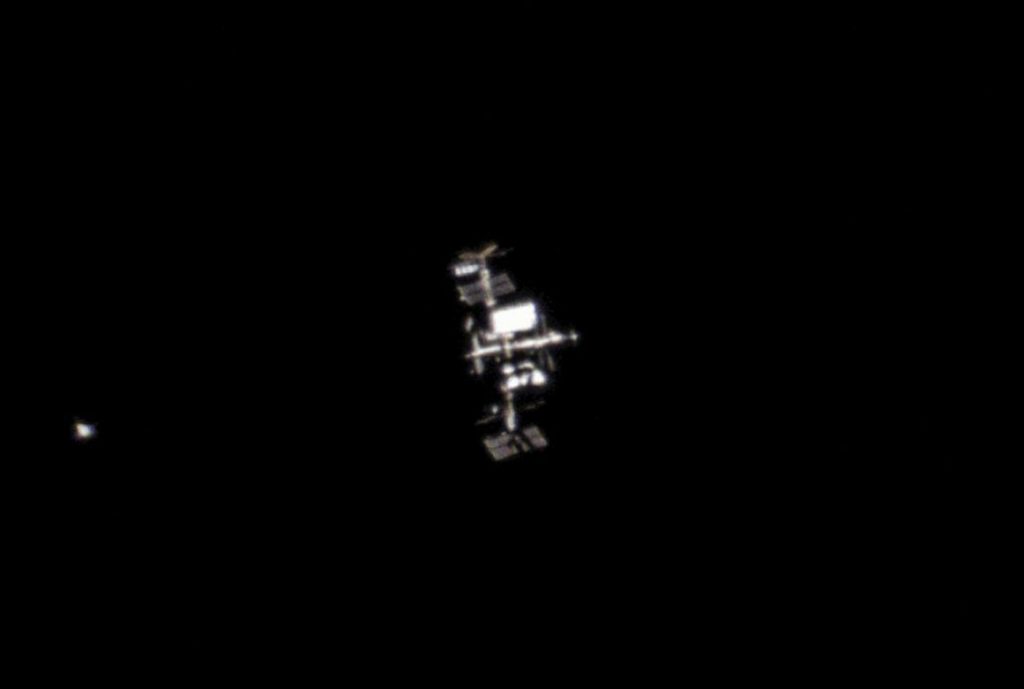
Wow! International Space Station and Boeing Starliner captured in the same incredible image (Image Credit: Space.com)

Set phasers to stunned: A photographer on the ground spotted a spacecraft 250 miles (400 kilometers) overhead, just about to meet up with the International Space Station (ISS).
Szabolcs Nagy, a space station tracker and photographer in London, captured Boeing’s Starliner just 650 feet (200 meters) from the orbiting complex as the uncrewed Orbital Flight Test 2 (OFT-2) made a historic docking on May 20.
“I was listening to the conversation between Mission Control and ISS crew whilst taking photos with my telescope in the garden,” Nagy, who also created SpaceStationGuys.com (opens in new tab), told Space.com.
In photos: Boeing’s Starliner OFT-2 mission in pictures
Live updates: Starliner’s OFT-2 mission
“It felt like no other ISS imaging session before,” added Nagy, who enhanced his camera’s view using a 14-inch Dobsonian telescope with manual tracking, along with a 3x Barlow lens to increase the system’s focal length.
This is the International Space Station with the #Boeing #Starliner at 200 meters distance.This whole experience was surreal, so so happy! @Cmdr_Hadfield @Space_Station @BoeingSpace @richard_e_cole @NASASpaceflight #ISS pic.twitter.com/EIPxtoMATHMay 20, 2022
OFT-2 successfully met all major objectives as Starliner is seeking to ship astronauts to the space station on future flights. While the spacecraft’s mission results are still being judged against metrics with NASA officials, indications so far point to a crew going aboard Starliner later in the year.
Nagy described his photography session as “a totally surreal experience, really.” In the moment, he wasn’t sure if the two vehicles could fit in a single field of view, but everything was bright enough and close enough to capture a few thousand frames of the encounter, he said.
As you can see below, this image wasn’t the only one he produced during the mission. And in between photography sessions, he was uploading Starliner mission content on his YouTube channel (opens in new tab).
Comparison image👀 @BoeingSpace #Starliner vs. @SpaceX #CrewDragon. 📷14″ Dob with manual tracking 3xBarlow @zwoasi 174MM with A.P 642 IR PASS filter. @spacestationguy #SpotTheStation @VirtualAstro #astrophotography #ESA #NASA @BoeingSpace @skyatnightmag #Telescope pic.twitter.com/MYofoZ6FsDMay 25, 2022
#Boeing #Starliner comparison image. 14″ Dob with manual tracking 3xBarlow @zwoasi 174MM with A.P 642 IR PASS filter. @spacestationguy #SpotTheStation @VirtualAstro #astrophotography #ESA #NASA @BoeingSpace @skyatnightmag @redditSpacePorn #Telescope #ISS @Space_Station pic.twitter.com/6cBI3fzAbGMay 21, 2022
Geraint Jones, a professor and head of the Planetary Science Group at University College London, photographed the spacecraft and station during docking procedures from his location in Guildford, Surrey. Jones snapped his image (opens in new tab) with a handheld camera only an hour’s drive southwest from where Nagy stood.
Starliner and #ISS passing over the UK at 23:10 BST this evening – no processing. Handheld with Nikon P1000. Taken from Guildford, Surrey. Around 1 hour from automatic docking. #Starliner #OFT2 #spacestation #astrophotography pic.twitter.com/JGMmB2vqlrMay 20, 2022
As for Nagy, he was back at his camera during the reentry of Starliner five days later, as the Boeing spacecraft zoomed through the atmosphere en route to a safe parachute landing at White Sands Space Harbor in New Mexico.
“Check out the full video of the event; it was spectacular,” Nagy said on Twitter (opens in new tab) May 25, adding, “As I tweet, Starliner is deploying the heat shield. Sooo cool.”
@Boeing #Starliner and the International Space Station over London.Check out the full video of the event, it was spectacular! As I tweet Starliner is deploying the heat shield. Sooo cool 😁@Space_Station #ISSBetter quality video 👉https://t.co/0INBBHvZ1a pic.twitter.com/GqlPwUymWNMay 25, 2022
Follow Elizabeth Howell on Twitter @howellspace (opens in new tab). Follow us on Twitter @Spacedotcom (opens in new tab) and on Facebook (opens in new tab).





